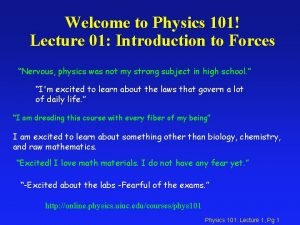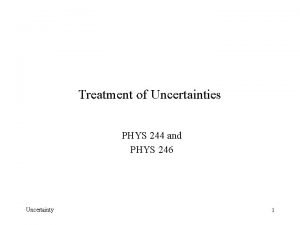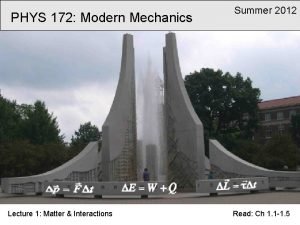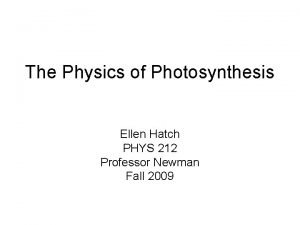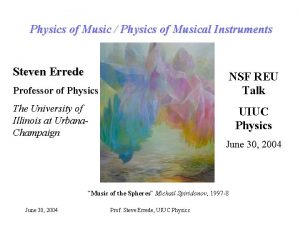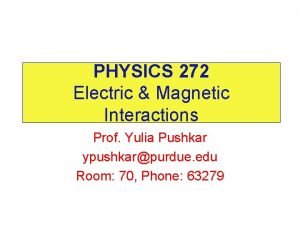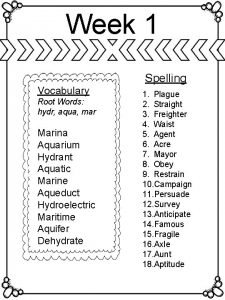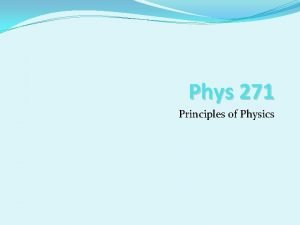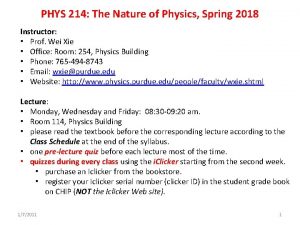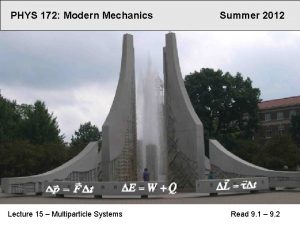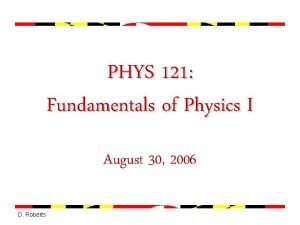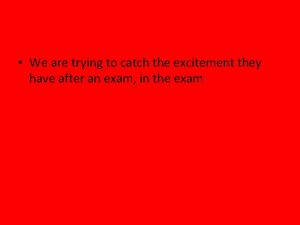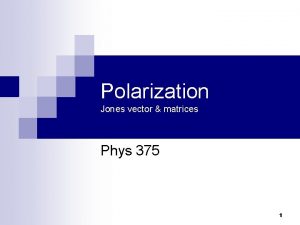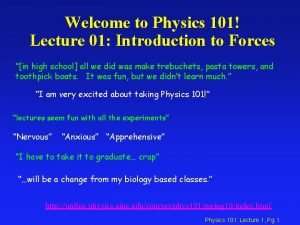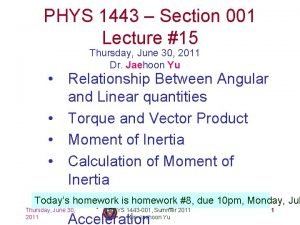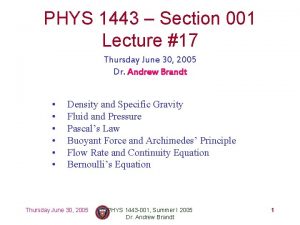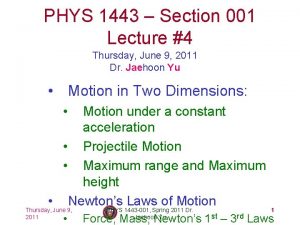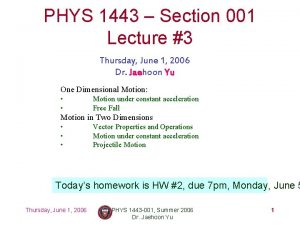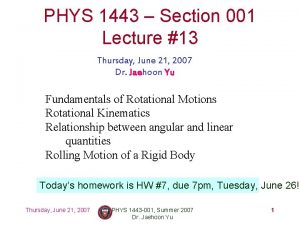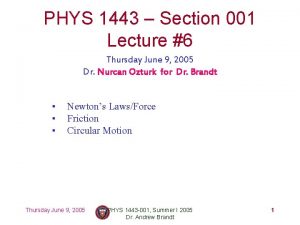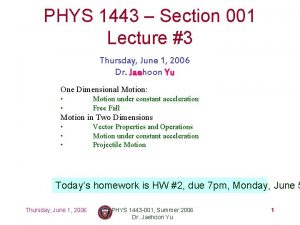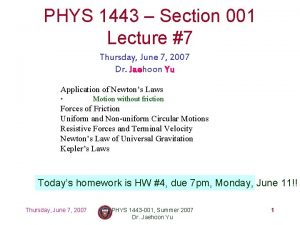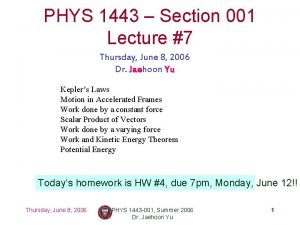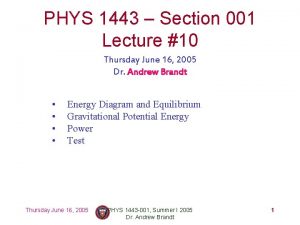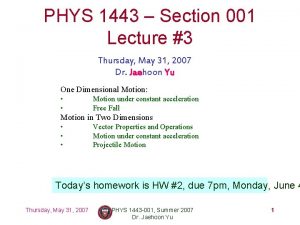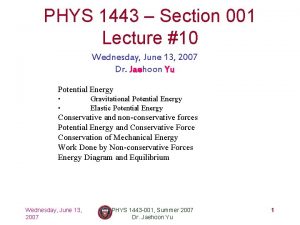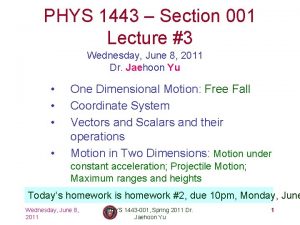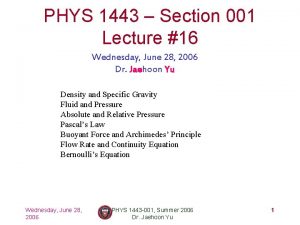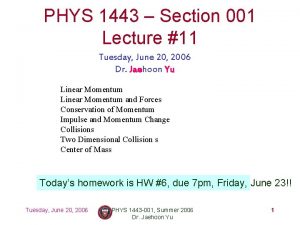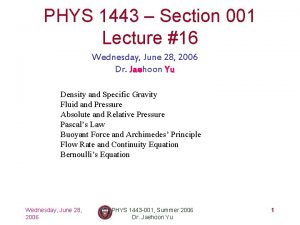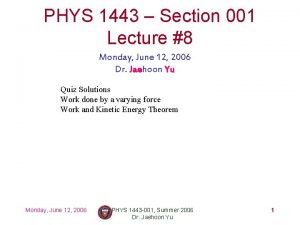PHYS 1443 Section 001 Lecture 14 Thursday June




















- Slides: 20

PHYS 1443 – Section 001 Lecture #14 Thursday June 23, 2005 Dr. Barry Spurlock for Dr. Brandt • • 10/18/2021 Rotational Variables Rotational Motion Rolling Motion Torque PHYS 1443 -001, Summer I 2005 Dr. Andrew Brandt 1

Announcements • Homework: – HW 8 on ch 9 due Friday 6/24 at 5 pm • TEST 3 Monday 6/27 Ch 7 -9 (work, cons of energy, momentum, potential energy, and collisions) 10/18/2021 PHYS 1443 -001, Summer I 2005 Dr. Andrew Brandt 2

Fundamentals of Rotation Linear motions can be described as the motion of the center of mass with all the mass of the object concentrated on it. Is this still true for rotational motions? No, because different parts of the object have different linear velocities and accelerations. Consider a motion of a rigid body – an object that does not change its shape – rotating about the axis protruding out of the slide. The arc length, or sergita, is the angle, q, is Therefore. And the unit of the angle is in radian. It is dimensionless!! One radian is the angle swept by an arc length equal to the radius of the arc. the circumference of a circle is Since 2 pr, The relationship between radian and degrees is 10/18/2021 PHYS 1443 -001, Summer I 2005 Dr. Andrew Brandt 3

Example 10 – 1 A particular bird’s eyes can barely distinguish objects that subtend an angle no smaller than about 3 x 10 -4 rad. (a) How many degrees is this? (b) How small an object can the bird just distinguish when flying at a height of 100 m? (a) One radian is 360 o/2 p. Thus (b) Since l=rq and for small angle arc length is approximately the same as the chord length. 10/18/2021 PHYS 1443 -001, Summer I 2005 Dr. Andrew Brandt 4

Rotational Kinematics The first type of motion we learned about in linear kinematics was under a constant acceleration. We will learn about the rotational motion under constant angular acceleration, because these are the simplest motions in both cases. Just like the case in linear motion, one can obtain Angular Speed under constant angular acceleration: Angular displacement under constant angular acceleration: One can also obtain 10/18/2021 PHYS 1443 -001, Summer I 2005 Dr. Andrew Brandt 5

Angular Displacement, Velocity, and Acceleration Using what we have learned in the previous slide, how would you define the angular displacement? How about the average angular speed? Unit rad/s ? And the instantaneous angular speed? Unit rad/s ? the same token, the average By qf qi angular acceleration Unit rad/s 2 And the instantaneous angular ? acceleration? Unit rad/s 2 ? When rotating about a fixed axis, every particle on a rigid object rotates through the same angle and has the same angular speed PHYS 1443 -001, Summer I 2005 6 and 10/18/2021 angular acceleration. Dr. Andrew Brandt

Example for Rotational Kinematics A wheel rotates with a constant angular acceleration of 3. 50 rad/s 2. If the angular speed of the wheel is 2. 00 rad/s at ti=0, a) through what angle does the wheel rotate in 2. 00 s? Using the angular displacement formula in the previous slide, one gets 10/18/2021 PHYS 1443 -001, Summer I 2005 Dr. Andrew Brandt 7

Example for Rotational Kinematics cnt’d What is the angular speed at t=2. 00 s? Using the angular speed and acceleration relationship Find the angle through which the wheel rotates between t=2. 00 s and t=3. 00 s. Using the angular kinematic formula At t=2. 00 s At t=3. 00 s Angular displaceme 10/18/2021 PHYS 1443 -001, Summer I 2005 nt Dr. Andrew Brandt 8

Relationship Between Angular and Linear Quantities What do we know about a rigid object that rotates about a fixed axis of rotation? Every particle (or masslet) in the object moves in a circle centered at the axis of rotation. For a point on a rotating body we can consider both the linear and angular components in its motion The direction What is the linear component of the motion you see? Linear velocity along the tangential direction. How do we related this linear component of the motion with angular component? of w follows a righthand rule. The arc-length So the tangential speed v is is What does this relationship tell you Although every particle in the object has about the tangential speed of the same angular speed, its tangential points in the object and their speed differs proportional to its distance angular speed? : from the axis of rotation. The Summer farther away 10/18/2021 PHYS 1443 -001, I 2005 the particle is from the 9 Dr. Andrew center. Brandt of rotation, the higher the

Is the lion faster than the horse? A rotating carousel has one child sitting on a horse near the outer edge and another child on a lion halfway out from the center. (a) Which child has the greater linear speed? (b) Which child has the greater angular speed? (a) Linear speed is the distance traveled divided by the time interval. So the child sitting at the outer edge travels more distance within the given time than the child sitting closer to the center. Thus, the horse is faster than the lion. (b) Angular speed is the angle traveled divided by the time interval. The angle both the children travel in the given time interval is the same. Thus, both the horse and the lion have the same angular speed. 10/18/2021 PHYS 1443 -001, Summer I 2005 10 Dr. Andrew Brandt

How about the acceleration? How many different linear accelerations do you see in a circular motion and what Tw are they? o Tangential, a , and the radial t acceleration, ar. speed v Since the tangential What does this relationship tell you? is The magnitude of tangential acceleration at is Although every particle in the object has the same angular acceleration, its tangential acceleration differs proportional to its distance from the axis of rotation. The radial or centripetal acceleration ar is What does The father away the particle is from the rotation axis, the this tell more radial acceleration it receives. In other words, it you? receives more centripetal force. Total linear acceleration is 10/18/2021 PHYS 1443 -001, Summer I 2005 Dr. Andrew Brandt 11

Example (a) What is the linear speed of a child seated 1. 2 m from the center of a steadily rotating merry-go-around that makes one complete revolution in 4. 0 s? (b) What is her total linear acceleration? First, figure out what the angular speed of the merrygo-around is. Using the formula for linear speed Since the angular speed is constant, there is no angular acceleration. Tangential acceleration is Radial acceleration is Thus the total acceleration 10/18/2021 is PHYS 1443 -001, Summer I 2005 Dr. Andrew Brandt 12

Example for Rotational Motion Audio information on compact discs are transmitted digitally through the readout system consisting of a laser and lenses. The digital data on the disc are stored by the pits and flat areas on the track. Since the speed of the readout system is constant, it reads out the same number of pits and flats in the same time interval. In other words, the linear speed is the same no matter which track is played. a) Assuming the linear speed is 1. 3 m/s, find the angular speed of the disc in revolutions per minute when the inner most (r=23 mm) and outer most tracks (r=58 mm) are read. Using the relationship between angular and tangential speed b) The maximum playing time of a standard music CD is 74 minutes and 33 seconds. How many revolutions does the disk make during that time? c) What is the total length of the track past through the readout mechanism? d) What is the angular acceleration of the CD over the 4473 s time interval, assuming constant a? 10/18/2021 PHYS 1443 -001, Summer I 2005 Dr. Andrew Brandt 13

Rolling Motion of a Rigid Body What is a rolling motion? To simplify the discussion, let’s make a few assumptions A more generalized case of a motion where the rotational axis moves together withmotion the object A rotational about the moving axisdiscussion on very 1. Limit our symmetric objects, such as cylinders, spheres, etc 2. The object rolls on a flat surface Let’s consider a cylinder rolling without slipping on a flat surface Under what condition does this “Pure Rolling” happen? The total linear distance the CM of the cylinder moved is R q s s=Rq 10/18/2021 Thus the linear speed of the CM is Condition PHYS 1443 -001, Summer I 2005 Dr. Andrew Brandt Rolling” for “Pure 14

More Rolling Motion of a Rigid Body The magnitude of the linear acceleration of the CM is P’ CM P 2 v. CM As we learned in the rotational motion, all points in a rigid body moves at the same angular speed but at a different linear speed. v. CM At any given time the point that comes to P has Why? 0 linear speed while the point at P’ has twice ? the speed of CM CM is moving at the same speed at all times. A rolling motion can be interpreted as the sum of Translation 2 v. CM v=Rw and Rotation v. CM P’ P’ P’ CM P 10/18/2021 v. CM + CM v=0 v=Rw = P PHYS 1443 -001, Summer I 2005 Dr. Andrew Brandt CM v. CM P 15

Torque is the tendency of a force to rotate an object about an axis. Torque, t, is a vector quantity. F f r P Line of Action d 2 d Mome nt arm F 2 Consider an object pivoting about the point P by the force F being exerted at a distance r. extends from the tail of The line that the force vector is called the line of action. The perpendicular distance from the pivoting point P to the line of action is called Moment arm. Magnitude of torque is defined as the product of the force exerted on the object to rotate it and the moment arm. When there are more than one force being exerted on certain points of the object, one can sum up the torque generated by each force vectorially. The convention for sign of the torque is positive if rotation is in counter 10/18/2021 PHYS 1443 -001, Summer I 2005 clockwise and negative if clockwise. Dr. Andrew Brandt 16

Example for Torque A one piece cylinder is shaped as in the figure with core section protruding from the larger drum. The cylinder is free to rotate around the central axis shown in the picture. A rope wrapped around the drum whose radius is R 1 exerts force F 1 to the right on the cylinder, and another force exerts F 2 on the core whose radius is R 2 downward on the cylinder. A) What is the net torque acting on the cylinder about the rotation axis? F 1 The torque due to and due to R 1 F 2 So the total torque R 2 acting on the system by F 2 the forces is Suppose F 1=5. 0 N, R 1=1. 0 m, F 2= 15. 0 N, and R 2=0. 50 m. What is the net torque about the rotation axis and which way does the cylinder rotate from the rest? Using the The cylinder above rotates in counterresult clockwise. 10/18/2021 PHYS 1443 -001, Summer I 2005 Dr. Andrew Brandt 17

z O Torque and Vector Product Let’s consider a disk fixed onto the origin O and the force F is exerted on the point p. t=rx. F What happens? The disk will start rotating counter clockwise about the r p y Z axis The magnitude of torque given to the disk by the F force F is q x But torque is a vector quantity, what is the direction? How is torque expressed mathematically? What is the The direction of the torque follows the rightdirection? hand rule!! The above quantity is called Vector product or Cross product What is the result of a vector What is another vector operation we’ve product? learned? Another Scalar vector 10/18/2021 PHYS 1443 -001, Summer I 2005 18 product Result? A Dr. Andrew Brandt

Properties of Vector Product is Non. What does this commutative mean? If the order of operation changes the result changes Following the right-hand rule, the direction changes Vector Product of two parallel vectors is 0. Thus, If two vectors are perpendicular to each other Vector product follows distribution law The derivative of a Vector product with respect to a scalar variable is 10/18/2021 PHYS 1443 -001, Summer I 2005 Dr. Andrew Brandt 19

More Properties of Vector Product The relationship between unit vectors, Vector product of two vectors can be expressed in the following determinant form 10/18/2021 PHYS 1443 -001, Summer I 2005 Dr. Andrew Brandt 20
 Phys 241 lecture quizzes
Phys 241 lecture quizzes 01:640:244 lecture notes - lecture 15: plat, idah, farad
01:640:244 lecture notes - lecture 15: plat, idah, farad Physics 102 uiuc
Physics 102 uiuc Phys 101 uiuc
Phys 101 uiuc Ucsd physics
Ucsd physics Calculating a percent difference
Calculating a percent difference Phys 172
Phys 172 Http //www.phys.hawaii.edu/ teb/optics/java/slitdiffr/
Http //www.phys.hawaii.edu/ teb/optics/java/slitdiffr/ Http //www.phys.hawaii.edu/ teb/optics/java/slitdiffr/
Http //www.phys.hawaii.edu/ teb/optics/java/slitdiffr/ Phys 212 equation sheet
Phys 212 equation sheet Phys 398 uiuc
Phys 398 uiuc Coulomb units
Coulomb units What does att phys mean in medical terms
What does att phys mean in medical terms Hydr root
Hydr root Phys 271
Phys 271 Phys 214
Phys 214 Particl clicker
Particl clicker Phys 121 umd
Phys 121 umd Phys 250 ubc
Phys 250 ubc Quarter wave plate jones matrix
Quarter wave plate jones matrix Physics 101 uiuc
Physics 101 uiuc



